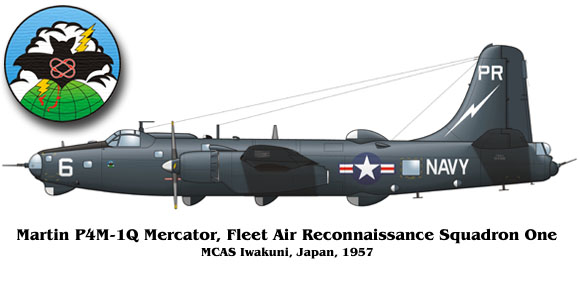

At the height of the Cold War, Martin Mercators flew clandestine
ferret missions to gather electronic intelligence from China, North Korea,
the USSR and Vietnam. The Mercator flew with just one US Navy patrol
squadron (VP-21) as the P4M-1 before entering the sinister world of Cold
War 'black cover' reconnaissance as the P4M-1Q. Officially the P4M-1Q
Mercator belonged first to 'warning' and later to 'electronic
countermeasures' squadrons even though, in fact, it never performed either
duty.
Contemporary with the Lockheed P2V Neptune, The
Mercator was conceived in 1944 as a replacement for the Consolidated PB4Y
Privateer, and particularly for the specific role of mine-laying during
the attack on, and invasion of Japan. The Neptune, on the other hand, was
always intended as a replacement for the smaller, shorter-ranged,
twin-engined Lockheed Ventura, and had been launched (as a private
venture) in September 1941. This "head start" was destined to have
far-reaching effects. The Martin Model 219 reflected the Navy's interest
in combining the benefit of high performance over target with very long
range. The solution, in the case of the Mercator, was a 'mix' of
reciprocating and jet engines. The Mercator's power plant comprised two
2,975hp Pratt & Whitney R-4360 Wasp Major radial engines (among the
biggest and most complex piston engines ever put into the air) plus two
3,8251b thrust Allison J33-A-17 turbojet engines, with each nacelle
holding one reciprocating and one jet engine. This compound prop-jet
arrangement has been compared with the Neptune, but the latter did not
have jets added to its two piston engines until long after entering
service, and then only as an afterthought. The Mercator was a prop-jet
warplane from the beginning.
Unfortunately for Martin, Lockheed's
Ventura replacement emerged as a much more capable aircraft than the Navy
had asked for. About one-third smaller than the Mercator, the Neptune was
powered by Wright Cyclone engines with roughly the same output as the
Mercator's primary reciprocating engines, yet was much lighter. It was
able to carry a similar fuel load. As a result, the Neptune had a longer
range than the four-engined Mercator, and had a significantly lower price
tag. The Neptune was also ready first and this would eventually prove to
be critical. Martin would produce only 19 Mercators for the Navy.
Most of the P4M-1s were delivered to VP-21, stationed at Patuxent
River Naval Air Station in Maryland and later at Port Lyautey in Morocco.
Fast and heavily armed, the Mercators were better suited to bombing and
mine-laying missions in hostile airspace than to antisubmarine patrol.
Maintenance problems with the turbojets led to temporary restrictions on
their use, but after a series of successful and well publicized long-range
flights, the restrictions were lifted and squadron morale improved. Yet
however successful the P4M-1 was in service, it made little sense to have
a single patrol squadron operating Mercators, while the rest of the patrol
community operated Neptunes.
While no one in the higher echelons
of the patrol community really knew what to do with the Mercator, the
lumbering Privateer was beginning to show increasing vulnerability in the
electronic and radar reconnaissance roles. The Mercators had obvious
potential as PB4Y replacements. Diverting Neptunes as Privateer
replacements made no sense at all, since they were too small, too slow and
too limited even before the addition of heavy electronic equipment and
extra crew stations. Beginning in 1950, all but one of the production
models (121452, lost in an accident in Chesapeake Bay on March 8, 1951)
were specifically modified by the Navy for electronic reconnaissance as
P4M-lQs, the last conversion being completed in October 1951. Externally,
the electronics aircraft could be recognized by their four white ventral
radomes, rather than the two of the original production version. Several
of the Q ships also had large dorsal radomes in place of the upper gun
turrets. The crew was increased to 14 (adding five more electronics
operators and an aircraft captain, who could also serve as a relief
gunner), loaded weight increased to 88,378 pounds, although the range
dropped to 2,000 miles.
P4M-1Q crews trained with composite
squadron VC-11 at NAS Miramar, California during April-September 1951, and
four aircraft began operations from Naval Station Sangley Point, in the
Philippine Islands in October. Serving with a variety of small, secret
units, their tail numbers sometimes disguised, Mercators of the "Special
Products Division" of the Air Operations Department and "Detachment A" of
Airborne Early Warning Squadrons One and Three (VW-1 and VW-3) were
dispatched to monitor radar and radio signals along the coasts of the
Soviet Union and its allies, Communist Vietnam, China and North Korea.
Extended patrol missions, beginning in the Philippines and ending in
Japan, often lasted as long as 14 hours. They were conducted mainly at
night, the planes loaded with electronic black boxes and the large crew of
pilots, operators and gunners.
Occasionally these spy flights met
with opposition. After a Moraccan-based Mercator crashed in the eastern
Mediterranean in February 1952, rumors suggested that it had been
attacked. Another Mercator was definitely shot down by Chinese MiG-15
fighters near Shanghai in 1956. Still another fought off attacks by two
North Korean MiG-17s in 1959, the tail gunner being wounded. Back in the
Mediterranean, a P4M-1Q of VQ-2, operating from Incirlik, Turkey, crashed
with the loss of all sixteen crewman aboard in January, 1960. The last
Mercator was retired in July 1960.
Perhaps minor in scale compared
to the widespread service of the Lockheed Neptune, the unusual and very
important surveillance role carried out by the Mercator required a highly
specialized airplane with great endurance, substantial fuel and
electronics capacity, effective defensive armament, and sudden dash speed.
The Martin P4M-1 Mercator met all these needs handsomely during a crucial
period in American history. Today, 40 years later, not a single example
survives. |

